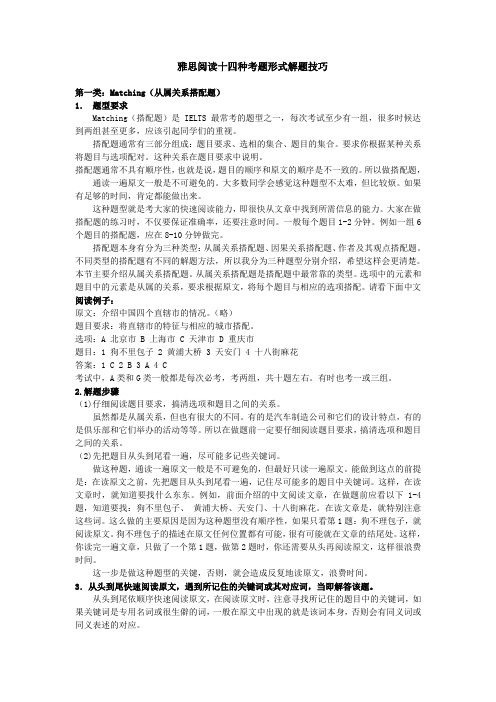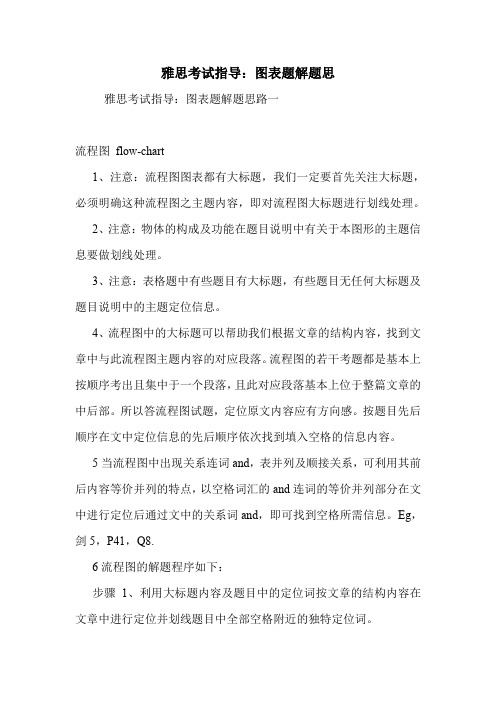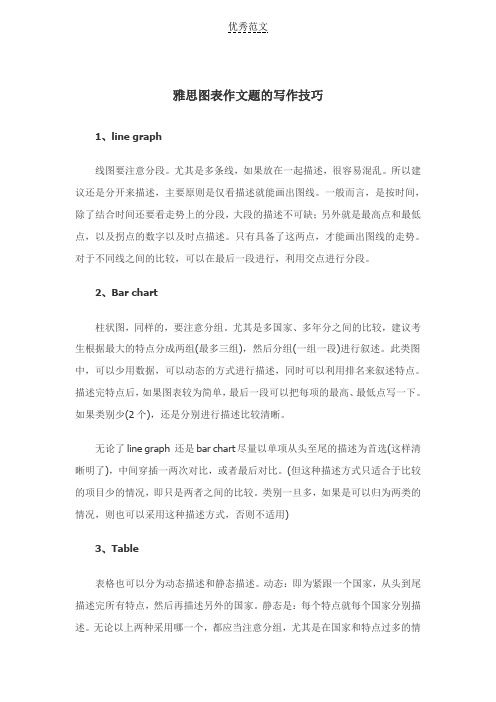雅思阅读14类题型解题技巧之Diagram_Flowchart_Tablecompletion
雅思阅读十四种考题形式解题技巧

雅思阅读十四种考题形式解题技巧第一类:Matching(从属关系搭配题)1.题型要求Matching(搭配题)是IELTS 最常考的题型之一,每次考试至少有一组,很多时候达到两组甚至更多,应该引起同学们的重视。
搭配题通常有三部分组成:题目要求、选相的集合、题目的集合。
要求你根据某种关系将题目与选项配对。
这种关系在题目要求中说明。
搭配题通常不具有顺序性,也就是说,题目的顺序和原文的顺序是不一致的。
所以做搭配题,通读一遍原文一般是不可避免的。
大多数同学会感觉这种题型不太难,但比较烦。
如果有足够的时间,肯定都能做出来。
这种题型就是考大家的快速阅读能力,即很快从文章中找到所需信息的能力。
大家在做搭配题的练习时,不仅要保证准确率,还要注意时间。
一般每个题目1-2分钟。
例如一组6个题目的搭配题,应在8-10分钟做完。
搭配题本身有分为三种类型:从属关系搭配题、因果关系搭配题、作者及其观点搭配题。
不同类型的搭配题有不同的解题方法,所以我分为三种题型分别介绍,希望这样会更清楚。
本节主要介绍从属关系搭配题。
从属关系搭配题是搭配题中最常靠的类型。
选项中的元素和题目中的元素是从属的关系,要求根据原文,将每个题目与相应的选项搭配。
请看下面中文阅读例子:原文:介绍中国四个直辖市的情况。
(略)题目要求:将直辖市的特征与相应的城市搭配。
选项:A 北京市 B 上海市 C 天津市 D 重庆市题目:1 狗不里包子 2 黄浦大桥 3 天安门 4 十八街麻花答案:1 C 2 B 3 A 4 C考试中,A类和G类一般都是每次必考,考两组,共十题左右。
有时也考一或三组。
2.解题步骤(1)仔细阅读题目要求,搞清选项和题目之间的关系。
虽然都是从属关系,但也有很大的不同。
有的是汽车制造公司和它们的设计特点,有的是俱乐部和它们举办的活动等等。
所以在做题前一定要仔细阅读题目要求,搞清选项和题目之间的关系。
(2)先把题目从头到尾看一遍,尽可能多记些关键词。
雅思考试指导:图表题解题思

雅思考试指导:图表题解题思雅思考试指导:图表题解题思路一流程图flow-chart1、注意:流程图图表都有大标题,我们一定要首先关注大标题,必须明确这种流程图之主题内容,即对流程图大标题进行划线处理。
2、注意:物体的构成及功能在题目说明中有关于本图形的主题信息要做划线处理。
3、注意:表格题中有些题目有大标题,有些题目无任何大标题及题目说明中的主题定位信息。
4、流程图中的大标题可以帮助我们根据文章的结构内容,找到文章中与此流程图主题内容的对应段落。
流程图的若干考题都是基本上按顺序考出且集中于一个段落,且此对应段落基本上位于整篇文章的中后部。
所以答流程图试题,定位原文内容应有方向感。
按题目先后顺序在文中定位信息的先后顺序依次找到填入空格的信息内容。
5当流程图中出现关系连词and,表并列及顺接关系,可利用其前后内容等价并列的特点,以空格词汇的and连词的等价并列部分在文中进行定位后通过文中的关系词and,即可找到空格所需信息。
Eg,剑5,P41,Q8.6流程图的解题程序如下:步骤1、利用大标题内容及题目中的定位词按文章的结构内容在文章中进行定位并划线题目中全部空格附近的独特定位词。
步骤2、阅读文章时在流程图所涉及的段落处标记并在本段中查读在题目流程图信息中的关键定位词进行定位,并在定位句或其前后各一句中寻找题目空格所需信息, 空格所需信息内容在原题目中必须满足前后语言的逻辑含义及语法含义,在原文中的对应答案词汇要符合这种逻辑及语法关系。
在第一个步骤阅读流程图已知信息时,可以先根据空格前后语言内容预测一下空格处所应填入的信息词汇的内容及词性,满足空格所要求填入词汇与其前后语言内容的逻辑关系及语法关系。
注意:填入词汇的大小写按原文词汇的样式来。
7、注意:流程图一般给出的已知信息经常含有专业词汇或术语,考生不必担扰,这些词汇比较生僻,不可能使用原文同义替换内容,所以可直接在题目已知信息中划线定位后,在原文中找这些定位词的原词复现,即可于原文定位,并找到答案内容,题目中这些专业术语定位词不必翻译,也无必要理解其专业上的含义。
雅思阅读图表题怎么做

雅思阅读图表题怎么做雅思阅读图表题的解题技巧有这些:1.先读题干,明确答案的字数限制;2.依据已知寻找未知图表的小标题,图表中的关键文字;3.定位关键词,关键词通常都会比较容易在文中定位。
雅思阅读图表题的形式主要有统计表(Table),原理图(Diagram),流程图(Flow Chart)。
在准备雅思阅读图表题解题的时候,可以按照下面的方法进行:1.先读题干,明确答案的字数限制,答案不能超过规定字数。
2.解题密码就是:依据已知寻找未知图表的小标题,图表中的关键文字,图表中的说明及解释都是定位答案信息的重要依据。
关于Flow Chart和Table类型的题目,一定要读懂其结构形式,这一点关于提升答题的速度很关键。
3.结构越复杂的图表,其实定位关键词也越明确,通常都会比较容易在文中定位。
2雅思阅读推断正误题怎么做1.具体阅读并理解答题指引部分,确定答题方式。
2.确切理解问句的含义,严格按照文章本身意思理解和推断,不要想当然。
3.找出问句中的关键词语。
4.利用关键词语在文章中确定答案位置。
5.仔细查看文章中关键词语所在句子中的含义。
必要时应查看关键词语所在句子前后句子的含义。
认真区分false和not given,false与原文相反、相冲突;not give则不相冲突,但未提及。
6.可利用语法、词法推断答案所在相关句子的肯定与否定含义。
3雅思阅读段落标题题解答技巧1.首先在list of headings中划去做为例子的heading 或headings,以免在依据段落内容在list of headings中找出与其相匹配的段落标题时,它(它们)会干扰考试者对其他headings的选择。
2.在文章中把做为例子的段落划掉,以免对例子段落进行不必要的精读。
3.对题目中给出的段落,按照首句(第一、二句)、末句和中间句寻找主题句的方法,在list of headings中找出与其相匹配的段落标题。
4.如果时间同意,按照文章的段落顺序,对非题目中给出的段落及例子段落进行快速阅读,而对题目中给出并要求找出与其相匹配的段落标题的段落进行精读。
雅思图表作文题的写作技巧

雅思图表作文题的写作技巧1、line graph线图要注意分段。
尤其是多条线,如果放在一起描述,很容易混乱。
所以建议还是分开来描述,主要原则是仅看描述就能画出图线。
一般而言,是按时间,除了结合时间还要看走势上的分段,大段的描述不可缺;另外就是最高点和最低点,以及拐点的数字以及时点描述。
只有具备了这两点,才能画出图线的走势。
对于不同线之间的比较,可以在最后一段进行,利用交点进行分段。
2、Bar chart柱状图,同样的,要注意分组。
尤其是多国家、多年分之间的比较,建议考生根据最大的特点分成两组(最多三组),然后分组(一组一段)进行叙述。
此类图中,可以少用数据,可以动态的方式进行描述,同时可以利用排名来叙述特点。
描述完特点后,如果图表较为简单,最后一段可以把每项的最高、最低点写一下。
如果类别少(2个),还是分别进行描述比较清晰。
无论了line graph 还是bar chart尽量以单项从头至尾的描述为首选(这样清晰明了),中间穿插一两次对比,或者最后对比。
(但这种描述方式只适合于比较的项目少的情况,即只是两者之间的比较。
类别一旦多,如果是可以归为两类的情况,则也可以采用这种描述方式,否则不适用)3、Table表格也可以分为动态描述和静态描述。
动态:即为紧跟一个国家,从头到尾描述完所有特点,然后再描述另外的国家。
静态是:每个特点就每个国家分别描述。
无论以上两种采用哪一个,都应当注意分组,尤其是在国家和特点过多的情况下,分组描述,可以减少字数。
对于明显的两类,建议采用动态描述法,因为它们在每一项特点下都具有相似的规律,这样比较明晰。
两个图表的写作:一般分为两段,分别进行描述。
如果其中一个图特别简单,可以用最后一段简单描述,如果两个图表差不多复杂就采用1:1的比例,分别对各自特点进行描述,然后在最后一段将两者进行联系和比较。
雅思写作4、Pie饼图建议不要按一个一个饼来描述,而是根据饼中的信息进行分组描述,同样的注意动态描述和最值,这里不多加赘述了。
(完整版)Diagram,FlowChart,Map雅思写作流程图讲义

Flow chart Writing
Finally, in stage three, the goods with glass containers appear in the customer supermarkets and this is the end of the cycle and the beginning of the next.
Flow chart Writing
Then the second stage starts when the recycled glass is showered by high pressured water. After that, the glass objects are categorized by color into brown, green and clear ones, before they are conveyed into recycling plant.
Diagram
Diagram Writing
The diagram below shows the method of obtaining water outdoors. You should spend about 20 minutes on this task. You should write at least 150 words.
Flow chart Writing
Structure
Introduction Stage 1 Stage 2 … Conclusion (if needed)
Opening Sentence Struture
雅思阅读图表题的答题步骤和技巧

雅思阅读图表题的答题步骤和技巧雅思阅读图表题是最近一段时间里正在兴起的一种题型,都对于这种对很多考生来说都是很陌生的题型,我们在雅思备考的过程中一定要掌握其答题步骤和答题技巧,这样才能应对雅思阅读图表题这个题型。
雅思阅读图表题的答题步骤和技巧雅思阅读图表、示意图题型(table、chart or diagram completion)雅思阅读图表题题型是要根据文章所给出的信息,将图表内缺失的内容(或数据)填补出来。
在雅思阅读测试中,有很多种图表及示意图。
这些图表中虽然词/语不多,但却能够明确说明问题的答案。
通常这些图表会附在所给阅读文章之内,作为文章的一部分。
切记不可忽略这些图表。
雅思阅读图表题的答题技巧的关键在于分析图表中已存在的文字信息点所在,然后根据已给出的信息点寻找对应的信息。
雅思阅读图表题答题步骤和答题技巧:1. 详细查看答题指引,以确定图表为何种信息。
2. 查看例句,了解图表内容及答题方式。
3. 查看图表题目栏中词语及数字符号。
4. 查看图表中的说明及注释部分。
5. 利用问句中的关键词语,在所给图表中寻找答案。
以上就是为大家整理的关于雅思阅读图表题答题步骤和答题技巧的全部内容,非常详细,对于雅思阅读图表题的表现形式和答题相关的信息都有所提及。
雅思作为国际性考试阅读会考些什么很多雅思考生都有这样的问题,即正式雅思阅读考试过程中三篇文章一般那篇更难?或者应该怎么安排做题顺序呢?有些人会从正常的逻辑出发认为基本上是难度递增的;也会有人从自身的考试体会出发认为有时是第二篇,甚至篇最难。
这样种种不同的回答又催生了一个让人可笑的衍生问题:最难的文章出现在Passage 1、2、还是3的概率是多少?其实,分析认为,作为一种国际性的考试,雅思考试的阅读并没有那么多的“玄学”,由于每套题目都遵循一个标准出炉,意味着经过Testing Panel验证后合格的考题总体上应该是在一个难度水平线上的。
我们完全没有必要在这点上大做文章。
雅思图表作文写作技巧指引

图表作文写作技巧指引一、图表类型汉语英语饼图pie chart直方图或柱形图bar chart / histogram / column chart趋势曲线图line chart / curve diagram表格图table流程图或过程图flow chart / sequence diagram程序图processing/procedures diagram二、要点分析A. 表格图1横向比较: 介绍横向各个数据的区别,变化和趋势2纵向比较:介绍横向各个数据的区别,变化和趋势3无需将每一个数据分别说明,突出强调数据最大值和最小值,对比时要总结出数据对比最悬殊的和最小的说明:考察例举数字的能力和方法。
注意怎样通过举一些有代表性的数据来有效地说明问题。
B. 曲线图1极点说明: 对图表当中最高的,最低的点要单独进行说明2趋势说明: 对图表当中曲线的连续变化进行说明,如上升,下降,波动,持平3交点说明: 对图表当中多根曲线的交点进行对比说明说明:关键是把握好曲线的走向和趋势,学会general classification,即在第二段的开头部分对整个曲线进行一个阶段式的总分类,使写作层次清晰。
接下来在分类描述每个阶段的specific trend,同时导入数据作为你分类的依据。
注意不要不做任何说明就机械性的导入数据!可以使用一些比较native的单词和短语来描述trend。
C. 饼状图1介绍各扇面及总体的关系2各个扇面之间的比较,同类扇面在不同时间,不同地点的比较3重点突出特点最明显的扇面:最大的,最小的,互相成倍的D. 柱状图1.比较: similarity2.对比: difference)3.横向总结所有柱状图表的共性特征 & 分别描写各个柱子的个性特征E. 流程图1.首先说明:做什么工作的过程,目的是什么2.准备工作3.按时间/过程先后描述4.结果5.简单总结(可有可无)说明:注意流程图里的“因果关系”或每一流程的“承前启后”关系;表达每一流程的主体内容,阐明这种关系;揭示其内在联系或规律;最后,给予简要归纳和总结。
雅思阅读各题型名师精讲:图表填空题

雅思阅读各题型名师精讲:图表填空题
2016雅思阅读各题型名师精讲:图表填空题
Diagram/Flowchart/Table Completion图表填空题
题型概述: 图表题也是一类简单题型。
它最大的特点是图表和题目都遵从某种顺序。
解决方案:
1. 图表题的答案也是原文中的细节信息。
2.找出题目中的关键词。
3. 根据图表结构(框架层次)和内部关系(因果、递进、时间或空间变化等)逐层回原文找关键词的对应词(多是AA重现)。
注意:
1.注意字母大小写、单复数和数字的'单位以及是否有字数的限制(如果有例词,一定同例词保持一致)。
2.绝大多数的答案是原文原词,而且是原文中连续的几个词。
3. 要注意顺序性,即题目的顺序和原文的顺序基本一致。
- 1、下载文档前请自行甄别文档内容的完整性,平台不提供额外的编辑、内容补充、找答案等附加服务。
- 2、"仅部分预览"的文档,不可在线预览部分如存在完整性等问题,可反馈申请退款(可完整预览的文档不适用该条件!)。
- 3、如文档侵犯您的权益,请联系客服反馈,我们会尽快为您处理(人工客服工作时间:9:00-18:30)。
雅思阅读14类题型解题技巧之Diagram_Flowchart_Tablecompletion有没有觉得阅读练习做很多,却没什么进步。
下面给大家带来了雅思阅读14类题型解题技巧之Diagram/Flowchart/Table completion,希望能够帮助到大家,下面就和大家分享,来欣赏一下吧。
雅思阅读14类题型解题技巧之Diagram/Flowchart/Table completionDiagram/Flowchart/Table completion(填图填表题)1. 题型要求题目中有一个图表或一个表格,其中有一些信息,留出空格,要求根据*填空,一般没有选项可供选择。
所填的内容一般分为如下几类:(1) 时间、事件及人物。
图表中是原文中的一些事件及格其发生时间和涉及人物,给出一些已知信息,要求填其余的。
有时也可能只考其中的一项或两项。
时间往往只涉及到年代,不会涉及到具体的日期。
(2) 数字及排位。
这时要分清要求填的是具体的数字还是相应的排位。
题目要求中一般用RANK一词表示排位,也可以看题目所给的例子。
(3) 物体的构成及功能。
*的某一段提到了一个物体,讲述了它的构造和各部分的功能。
题目是该物体的简图,给出一些部件的名称及功能,要求填其余部件的名称及功能。
所填信息常常集中于原文中的一个段落。
(4) 流程图。
*的某一段提到了做一件事情的过程,题目以流程图的形式描述这个过程,要求填其中几个环节的内容。
(5) 抽象名词:图表中常常是*中提到的一些事物,根据图表中的关系填空,通常是分类关系。
所填信息常常集中于*的一个段落。
填空题类别较多,所填内容五花八门,但一般都比较容易。
有的定位容易,有的集中于原文中的一个段落。
这种题型,A类和G类一般都是每次必考,共五题左右。
2. 解题步骤(1) 找出题目中的关键词。
如果图表中涉及时间或数字,它们肯定是关键关键词,而且肯定是原文对应,即原文中出现的也是这些词本身。
如果图表中没有涉及时间或数字,往往要根据具体的意思,在已知的信息中确定一个关键词。
(2) 到原文中去找关键词的对应词。
(3) 仔细阅读对应词所在的句子,确定正确答案。
(4) 要注意顺序性,即题目的顺序和原文的顺序基本一致。
NOTICE1. 注意题目要求中是否有数字限制。
2. 绝大部分的答案是原文原词,而且是原文中连续的几个词。
3. 一般比较简单,注意快速答题。
填图填表题一般比较简单。
虽然有的题看起来比较吓人,如出现物体的构成及功能、流程图、抽象名词、图表等,实际上都能很好地对应到原文,而且涉及信息常常集中于原文中的一个段落。
最新雅思阅读全真模拟试题:数码节食Digital DietTelecommuting, Internet shopping and online meetings may save energy as compared with in-person alternatives, but as the digital age moves on, its green reputation is turning a lot browner. E-mailing, number crunching and Web searches in the U S. consumed as much as 61 billion kilowatt-hours last year, or 1.5 percent of the nations electricity—half of which comes from coal. In 2005 the computers of the world ate up 123 billion kilowatt- hours of energy, a number that will double by 20XX if present trends continue, according to Jonathan Koomey, a staff scientist at Lawrence Berkeley National laboratory. As a result, the power bill to run a computer over its lifetime will surpass the cost of buying the machine in the first place giving Internet and computer companies a business reason to cut energy costs, as well as an environmental one.BOne of the biggest energy sinks comes not from the computers themselves but from the air-conditioning needed to keep them from overheating. For every kilowatt-hour of energy used for computing m a data center, another kilowatt-hour is required to cool the furnacelike racks of servers.For Internet giant Google, this reality has driven efforts such as the installation of a solar array that can provide 30 percent of the peak power needs of its Mountain View, Calif., headquarters as well as increasing purchases of renewable energy. But to deliver Web pages within seconds, the firm must maintain hundreds of thousands of computer servers in cavernous buildings. "Its a good thing to worry about server energy efficiency," remarks Googles green energy czar Bill Weihl. "We are actively working to maximize the efficiency of our data centers, which account for most of the energy Google consumes worldwide " Google will funnel some of its profits into a new effort, dubbed R?? (for renewable energy cheaper than coal, as Google translates it) to make sources such as solar-thermal, high-altitude wind and geothermal cheaper than coal " within years, not decades," according to Weihl.DIn the meantime, the industry as a whole has employed a few tricks to save watts. Efforts include cutting down on the number of transformations the electricity itself must undergo before achieving the correct operating voltage; rearranging the stacks of servers and the mechanics of their cooling; and using software to createmultiple "virtual" computers, rather than having to deploy several real ones. Such visualization has allowed computer maker Hewlett-Packard to consolidate 86 data centers spread throughout the world to just three, with three backups, says Pat Tiernan, the firms vice president of social and environmental responsibility.EThe industry is also tackling the energy issue at the computer-chip level. With every doubling of processing power in recent years has come a doubling in power consumption. But to save energy, chipmakers such as Intel and AMD have shifted toso-called multicore technology, which packs multiple processors into one circuit rather than separating them. "When we moved to multicore—away from a linear focus on megahertz and gigahertz—and throttled down microprocessors, the energy savings were pretty substantial," says A Hyson Klein, Intels marketing manager for its Ecotech Initiative. Chipmakers continue to shrink circuits on the nanoscale as well, which "means a chip needs less electricity" to deliver the same performance, she adds.FWith such chips, more personal computers will meet various efficiency standards, such as Energy Star compliance (whichmandates that a desktop consume no more than 65 watts). The federal government, led by agencies such as NASA and the Department of Defense may soon require all their purchases to meet the Electronic Product Environmental Assessment Tool standard. And Google, Intel and others have formed the Climate Savers Computing, Initiative, an effort to cut power consumption from all computers by 50 percent by 20XX.GSleep modes and other power management tools built into most operating systems tan offer savings today. Yet about 90 percent of computers do not have such settings enabled, according to Klein. Properly activated, they would prevent a computer from leading to the emission of thousands of kilograms of carbon dioxide from power plants every year. But if powering down or unplugging the computer (the only way it uses zero power) is not an option, then perhaps the most environmentally friendly use of all those wasted computing cycles is in helping to model climate change. TheUniversity of Oxfords offers an opportunity to at least predict the consequences of all that coal burning.HC02Stats is a free tool that can be embedded into any Web site to calculate the carbon dioxide emissions associated with using it. That estimate is based on an assumption of 300 watts of power consumed by the personal computer, network and server involved— or 16.5 milligrams of C02 emitted every second of use. "The typical carbon footprint is roughly equivalent to 1.5 people breathing," says physicist Alexander Wissner-Gross ofHarvard University, who co-created the Web tool.Question 1-6Use the information in the passage to match the people (listed A-E) with opinions or deeds below. Write the appropriate lettersA-E in boxes 1-6 on your answer sheet.NB you may use any letter more than onceA Jonathan KoomeyB Ally son KleinC Pat TiernanD Bill WeihlE Alexander Wissner-Gross1 Figuring ways to optimize the utilization of energy in certain significant departments in the company2 A revolutionary improvement in a tiny but quite imperative component of the computers3 Targeting at developing alternative sources within the near future4 An astounding estimate on the energy to be consumed by computers in a short period based on an unchangeable trend5 A powerful technique developed for integration of resources6 A failure for the vast majority of computers to activate the use of some internal tools already available in themQuestion 7-10Do the following statements agree with the information given in Reading Passage?In boxes 7-10 on your answer sheet, writeTRUE if the statement is trueFALSE if the statement is falseNOT GIVEN if the information is not given in the passage7 To chill the sever does not take up considerable amount of energy needed for the computer.8 It seems that the number of the servers has a severe impact on the speed of the internet connection9 Several companies from other fields have a joint effort with the internet industry to work on the ways to save energy.10 Actions taken at a governmental level are to be expected to help with savings in the energy in the near future.Question 11-13SummuryComplete the following summary of the paragraphs of Reading Passage, using No More than Three words from the Reading Passage for each answer. Write your answers in boxes 11-13 on your answer sheet.The…11…has also been reached 10 save up energy in every possible way and the philosophy behind it lies in the fact that there is a positive correlation between the ability to process and the need for energy. In this context, some firms have switc hed to…12…which means several processors are integrated into one single circuit to make significant energy savings. What is more, they go onto…13…on an even more delicate level for the chips to save more energy while staying at the constant level in terms of the performance.*题目:Digital Diet篇章结构体裁说论文题目数码节食结构(一句话概括每段大意)A段:介绍目前计算机电量消耗情况。
